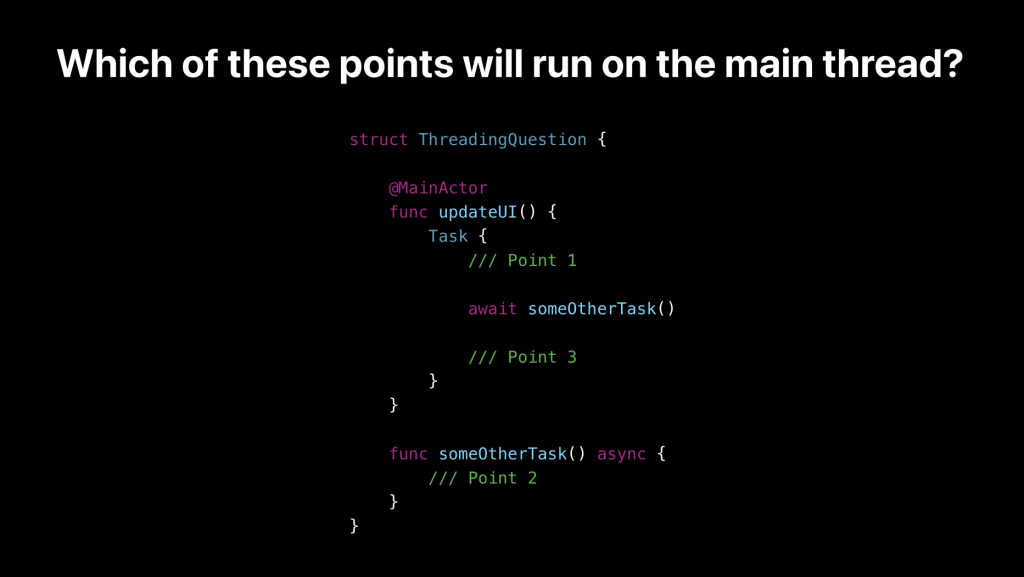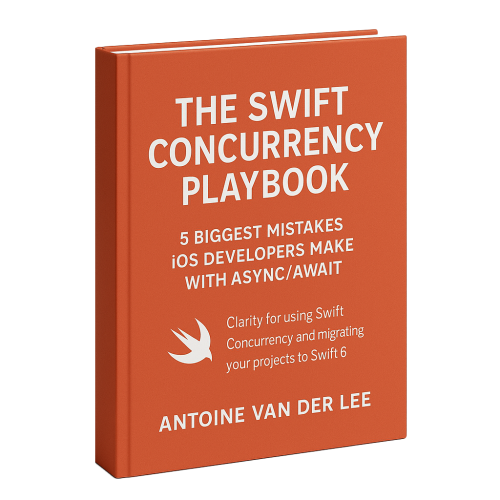Are Threads the same as Tasks in Swift Concurrency? You may wonder if you’re used to writing Swift or Objective-C using Grand Central Dispatch (GCD) and traditional APIs. A so-called threading mindset has helped us develop apps that work with asynchronous functions for years.
Modern concurrency uses Swift Concurrency and its async/await methodology. Instead of creating a closure-based method, you’ll be using a Task { ... } to start an asynchronous context. The next question you’re likely to ask yourself is whether this task will run on the main thread or a background thread. Whether that’s the case will be answered in this article, along with answering whether you should even consider the thread being used.
What is a thread?
Before we dive into deeper details, I’d like you to understand what thread actually is.
A thread is a system-level resource that runs a sequence of instructions. The operating system manages them, and threads have a high overhead when created or switched. Multithreading allows multiple operations to run concurrently, but managing these threads manually can be complex.
Due to this overhead and complexity, having the Swift Concurrency framework is a blessing. It prevents us from having to think directly about threads and prevents us from making potentially many mistakes.
Yet, if you’ve been developing in Swift for a while, you might be used to interacting more directly with threads. I personally did and created a “threading mindset”—when writing performant code, I’m often thinking about which thread it should be executing. Therefore, it’s beneficial to understand how Swift Concurrency works with threads and how it alleviates a significant amount of responsibility.
Swift Concurrency and Threads

The concurrency model in Swift is built on top of threads, but you’ll never interact with them directly. Swift doesn’t make any guarantee about which thread a function will run on.
For example, an async function could give up a thread it’s running on, letting another async function run on that thread while the first one is being blocked. When that first function resumes, there’s no guarantee which thread it will continue on.
Suspension points and threads
When working with tasks, there will be so-called suspension points. For example, when you use await, you’re essentially pausing execution of that piece of code until the asynchronous function returns.
This is also called yielding the thread, as Swift suspends the execution of your code on the current thread and might run some other code on that thread instead. This clearly explains why there’s no direct relationship between a single task and a single thread, and it also shows how well Swift can optimize concurrency.

FREE 5-Day Email Course: The Swift Concurrency Playbook
A FREE 5-day email course revealing the 5 biggest mistakes iOS developers make with with async/await that lead to App Store rejections And migration projects taking months instead of days (even if you've been writing Swift for years)
Tasks: A Higher-Level Abstraction
A task in Swift Concurrency is a unit of asynchronous work that runs within Swift’s cooperative thread pool. They’re not tied to a specific thread. They are scheduled and executed on any available threads. Swift dynamically manages task execution and ensures efficient thread usage. In other words, it prevents creating more threads than necessary, optimizing CPU efficiency.
What is Swift’s cooperative thread pool?
The cooperative thread pool is the execution model that Swift Concurrency uses to manage the execution of asynchronous tasks efficiently. Instead of creating a separate thread for each task (which can lead to excessive context switching and resource consumption), Swift dynamically schedules tasks on a limited number of system threads.
How Tasks are mapped to Threads
The earlier described cooperative thread pool is used to execute tasks efficiently. It avoids blocking threads and reduces unnecessary thread creation. This is a behind-the-scenes insight into why Swift Concurrency is so much better than what we’ve had before.
The system creates only as many threads as CPU cores. Tasks are scheduled onto available threads rather than getting its own thread each. When a suspension point occurs (as with await), the task will be suspended and another task is allowed to run on the same thread.
Here’s a code example to demonstrate this behavior:
struct ThreadingDemonstrator {
private func firstTask() async throws {
print("Task 1 started on thread: \(Thread.current)")
try await Task.sleep(for: .seconds(2))
print("Task 1 resumed on thread: \(Thread.current)")
}
private func secondTask() async {
print("Task 2 started on thread: \(Thread.current)")
}
func demonstrate() {
Task {
try await firstTask()
}
Task {
await secondTask()
}
}
}Note that you can only print Thread.current in Swift 5 language mode.
The above code example might print out something like:
Task 1 started on thread: <NSThread: 0x600001752200>{number = 3, name = (null)}
Task 2 started on thread: <NSThread: 0x6000017b03c0>{number = 8, name = (null)}
Task 1 resumed on thread: <NSThread: 0x60000176ecc0>{number = 7, name = (null)}This is explained as follows:
firstTask()starts, sleeps, and releases its threadsecondTask()runs and uses a different threadfirstTask()resumes and uses a different thread than when it started
This is possible because Swift Concurrency does not block threads while awaiting. In this case, it didn’t block any thread while sleeping. Swift 6.2 introduces the @concurrent attribute, which can demonstrate this behavior even more effectively.
Can Thread explosion still happen in Swift Concurrency?
The traditional Grand Central Dispatch (GCD) model could lead to a so-called thread explosion: when too many threads are created and blocking occurs. This results in:
- High memory overhead due to many idle threads.
- Excessive context switching: reduces CPU efficiency.
- Priority inversion issues: important tasks get stuck behind lower-priority tasks.
Swift Concurrency avoids thread explosion by only creating as many threads as CPU cores. It uses continuations instead of blocking threads, which allows more efficient use of available threads. This also ensures threads always make forward progress.
Does Swift Concurrency’s Limited Threads Reduce Performance Compared to GCD?
No, Swift Concurrency does not sacrifice performance compared to GCD, even though it limits the number of threads to match the number of CPU cores. Since it optimizes concurrency efficiency, it often outperforms GCD in real-world scenarios.
Why fewer threads doesn’t mean less performance
Counterintuitive, maybe, but fewer threads don’t mean less performance. Traditional GCD can create many more threads than CPU cores. While this may seem beneficial, it can lead to the earlier-mentioned thread explosion, excessive context switching, and CPU inefficiency.
Swift Concurrency, on the other hand, uses a fixed number of threads matching the CPU cores count. It prevents creating too many threads and ensures not to waste CPU cycles. It keeps CPU cores busy without excessive switching due to using continuations instead of blocking threads, which can add up if we talk about performance.
This reduced CPU overhead allows more work to be done per unit of time, often outperforming GCD.
Common misconceptions
Related to tasks and threads, there are a few common misconceptions:
- Misconception 1: Each Task runs on a new thread
- Misconception 2: await blocks the thread
- Misconception 3: Task Execution Order is Guaranteed
To better understand these, I’d like to invite you to my Swift Concurrency course at www.swiftconcurrencycourse.com. You’ll find 58+ in-depth lessons covering everything about Swift Concurrency.
Conclusion
Swift Concurrency allows us to eliminate the threading mindset and forces us to think in terms of instructions. The system will optimize threads usage automatically, resulting in the best performance possible. This reduces the overhead for us to manage threads manually, which can be complex and challenging to manage.
This article is a free lesson from my Swift Concurrency course. If you liked it, I invite you to continue your learning journey and start my essential course on Swift 6 and strict concurrency.
Thanks!